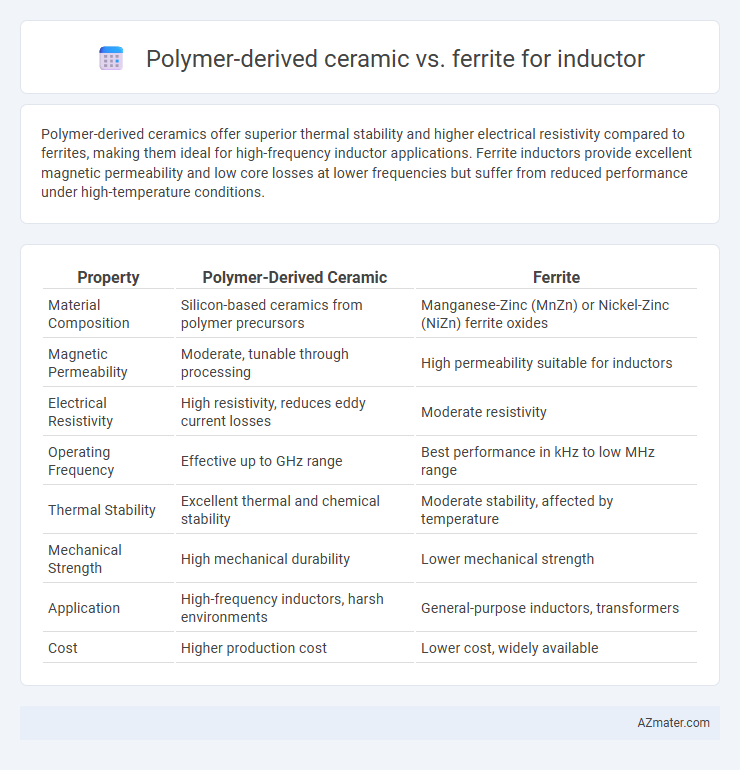Polymer-derived ceramics offer superior thermal stability and higher electrical resistivity compared to ferrites, making them ideal for high-frequency inductor applications. Ferrite inductors provide excellent magnetic permeability and low core losses at lower frequencies but suffer from reduced performance under high-temperature conditions.
Table of Comparison
| Property | Polymer-Derived Ceramic | Ferrite |
|---|---|---|
| Material Composition | Silicon-based ceramics from polymer precursors | Manganese-Zinc (MnZn) or Nickel-Zinc (NiZn) ferrite oxides |
| Magnetic Permeability | Moderate, tunable through processing | High permeability suitable for inductors |
| Electrical Resistivity | High resistivity, reduces eddy current losses | Moderate resistivity |
| Operating Frequency | Effective up to GHz range | Best performance in kHz to low MHz range |
| Thermal Stability | Excellent thermal and chemical stability | Moderate stability, affected by temperature |
| Mechanical Strength | High mechanical durability | Lower mechanical strength |
| Application | High-frequency inductors, harsh environments | General-purpose inductors, transformers |
| Cost | Higher production cost | Lower cost, widely available |
Introduction to Inductor Core Materials
Polymer-derived ceramics offer high thermal stability and excellent electrical insulation, making them suitable for inductor cores in high-frequency and high-temperature applications. Ferrite cores, composed mainly of iron oxide mixed with metallic elements, provide low core losses and high magnetic permeability, ideal for efficient energy storage in power inductors. The choice between polymer-derived ceramic and ferrite inductor cores depends on factors such as operating frequency, temperature range, and magnetic performance requirements.
Overview of Polymer-Derived Ceramics
Polymer-derived ceramics (PDCs) offer exceptional thermal stability, high electrical resistivity, and excellent mechanical properties, making them advantageous for inductor applications compared to traditional ferrite materials. PDCs exhibit superior chemical inertness and can operate efficiently at higher frequencies and elevated temperatures beyond the limits of ferrite cores. Their tunable microstructure and composition allow for custom magnetic and dielectric properties, enhancing performance in compact, high-power inductors used in advanced electronics.
Fundamentals of Ferrite Materials
Ferrite materials, composed primarily of iron oxide combined with metallic elements like manganese, zinc, or nickel, exhibit high magnetic permeability and low electrical conductivity, making them ideal for inductor cores that minimize eddy current losses at high frequencies. Polymer-derived ceramics (PDCs) provide excellent thermal stability and mechanical robustness but generally lack the magnetic properties and permeability required for efficient inductance in RF applications. Ferrites' intrinsic magnetic domains enable superior inductance density and lower core losses compared to PDCs, ensuring higher performance in electromagnetic devices operating across MHz to GHz frequency ranges.
Key Material Properties Comparison
Polymer-derived ceramics exhibit higher thermal stability and mechanical strength compared to ferrites, enabling inductors to operate reliably at elevated temperatures above 800degC. Ferrites offer lower magnetic losses and higher permeability at lower frequencies, making them suitable for high-frequency inductor applications up to a few MHz. The choice between polymer-derived ceramics and ferrites depends on the operational frequency range, thermal requirements, and mechanical durability needed for specific electronic inductor designs.
Magnetic Performance: PDC vs Ferrite
Polymer-derived ceramics (PDCs) exhibit superior thermal stability and higher saturation magnetization compared to traditional ferrite materials, enhancing the magnetic performance of inductors in high-frequency applications. PDCs provide lower core losses and better permeability stability under elevated temperatures, making them ideal for demanding power electronics environments. Ferrites, while cost-effective and widely used, typically suffer from higher core losses and reduced magnetic performance at higher frequencies and temperatures.
Thermal Stability and Endurance
Polymer-derived ceramics exhibit superior thermal stability compared to ferrite, withstanding temperatures up to 1400degC without significant degradation, while ferrite materials typically operate effectively below 300degC. The endurance of polymer-derived ceramic inductors is enhanced by their resistance to thermal shock and oxidation, ensuring prolonged performance in high-temperature environments. Ferrite inductors, though cost-effective, suffer from reduced magnetic permeability and increased core losses at elevated temperatures, limiting their reliability in demanding thermal applications.
Frequency Response and Losses
Polymer-derived ceramics exhibit superior high-frequency response and lower core losses compared to ferrite materials, making them ideal for inductors operating in the GHz range. Ferrites typically experience increased magnetic losses and reduced permeability at higher frequencies, leading to efficiency drops in high-frequency applications. The inherent structural stability and low eddy current losses of polymer-derived ceramics ensure consistent performance and minimal heat generation during high-frequency inductor operation.
Manufacturing and Cost Considerations
Polymer-derived ceramics offer superior thermal stability and allow for intricate geometries through low-temperature processing techniques, reducing manufacturing complexity compared to ferrite cores that require high-temperature sintering. The manufacturing cost of polymer-derived ceramics tends to be higher due to specialized precursor materials and curing processes, whereas ferrite inductors benefit from established mass-production methods and lower raw material expenses. Cost efficiency in ferrites makes them preferable for high-volume applications, while polymer-derived ceramics are favored in niche markets demanding enhanced performance and miniaturization.
Application Suitability and Industry Use
Polymer-derived ceramics exhibit high thermal stability and excellent electrical insulation, making them ideal for high-frequency and high-temperature inductor applications in aerospace and automotive industries. Ferrite inductors provide superior magnetic permeability and lower core losses, which are essential for power electronics and consumer electronics where energy efficiency and noise reduction are critical. The choice between polymer-derived ceramic and ferrite inductors depends on application-specific factors such as operating frequency, temperature ranges, and desired magnetic performance.
Future Trends in Inductor Core Materials
Polymer-derived ceramics (PDCs) offer superior thermal stability and higher operating frequencies compared to traditional ferrite cores, making them ideal for next-generation inductors in high-power and high-frequency applications. Advances in nanostructuring and composite formulations are enhancing the magnetic permeability and mechanical robustness of PDCs, driving their adoption in miniaturized and high-efficiency electronic devices. Ferrite materials remain cost-effective with well-established manufacturing processes but face limitations in saturation magnetization and frequency response, prompting a gradual shift toward ceramic-based cores for future inductor innovations.

Infographic: Polymer-derived ceramic vs Ferrite for Inductor
 azmater.com
azmater.com